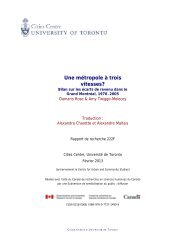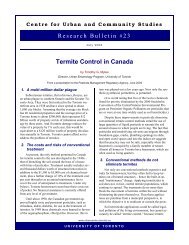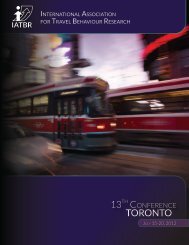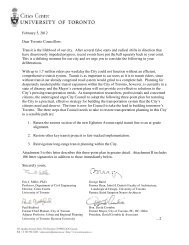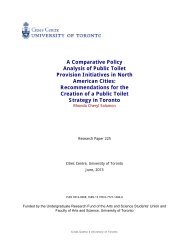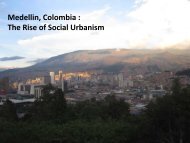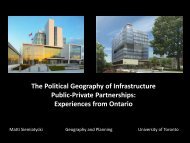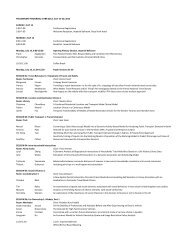Port Lands Letter Sept19 - Cities Centre - University of Toronto
Port Lands Letter Sept19 - Cities Centre - University of Toronto
Port Lands Letter Sept19 - Cities Centre - University of Toronto
You also want an ePaper? Increase the reach of your titles
YUMPU automatically turns print PDFs into web optimized ePapers that Google loves.
past when its competitors are boldly stepping into the future is a strategic mistake <strong>of</strong> the firstorder. If implemented, not only will these new proposals have dire consequences for the entire<strong>Toronto</strong> East End, they will represent a failure to capitalize on the once-in-a-lifetime opportunitythat we have to “get it right”.3. An Inferior Plan. The elements <strong>of</strong> the alternative plan so far released to the press quitesimply are shockingly inferior to the current plan. In particular:• The Lower Don <strong>Lands</strong> plan already provides for a large amount <strong>of</strong> retail space, both forresidents and visitors, but with active urban shopping streets rather than a megamall. Theproposed “destination shopping” complex is simply a very bad idea for many reasons.First, the need does not exist for another major shopping mall in the downtown:Councillor Ford’s assertion that there isn’t enough retail outside the Eaton <strong>Centre</strong> willcome as a surprise to the thousands <strong>of</strong> store owners and tens <strong>of</strong> thousands <strong>of</strong> retailemployees in downtown <strong>Toronto</strong>. Building a megamall would have a major negativeimpact on the retail core and especially all the successful retail strips that have devotedhuge efforts at revitalization through BIA's and hard work. Second, placing a major mallin this location would generate a transportation nightmare for the <strong>Toronto</strong> East Endrequiring a parking demand <strong>of</strong> approximately 6,000 spaces based on conventionalstandards which is a waste <strong>of</strong> valuable waterfront land. The overwhelming majority <strong>of</strong>shoppers travelling to this mall would come by car and would continue to do so once thespaces were provided. In addition, the road system in the East End could not reasonablyaccommodate this additional burden, leading to significantly increased congestion on ourroads and a significant degradation in the quality <strong>of</strong> life for all East End residents.• The proposed monorail is a technically inferior option to the recently cancelled LRT line.The proposed alternative would not be able to handle the volume or diversity <strong>of</strong>anticipated user needs. A transit focused waterfront would be abandoned in the process.• Malls do not represent a sustainable vision for prime waterfront lands in <strong>Toronto</strong>. In theU.S. 20% <strong>of</strong> the 2,000 malls are failing and a staggering half a billion square feet <strong>of</strong> retailspace lies empty. Even Wal Mart has abandoned 400 stores across the U.S. The greatirony in our current debate is that in many <strong>of</strong> these U.S. locations planning efforts areunderway to convert dead malls into mixed use centres with lots <strong>of</strong> residentialdevelopment! Here the proposal is to do the reverse. While the <strong>Toronto</strong> economy iscertainly stronger than in many parts <strong>of</strong> the U.S., no logical evidence has been presentedas to why this proposal for constructing massive amounts <strong>of</strong> new retail space iswarranted, either as an economic development or an urban development strategy.• Re-naturalizing the mouth <strong>of</strong> the Don through the three outlets <strong>of</strong> the existing planachieves flood-pro<strong>of</strong>ing while the Mayor's plan does not. It maintains the hard edgeKeating channel and allows for the water to simply flood a north-south park The proposalwill remove a lot <strong>of</strong> public park land, which is important both environmentally and as anattractive public space, much as in Chicago’s waterfront.• The existing plan can be financed from increased land values and resulting tax revenues.• Given the plethora <strong>of</strong> giant Ferris wheels already in existence around the world, thenotion <strong>of</strong> building one here on precious waterfront land is hardly a novel idea or one thatwill put <strong>Toronto</strong> “on the map” as a tourist attraction. In functional terms it is also largelyredundant, given the existence <strong>of</strong> the CN Tower, a truly iconic symbol for the City andone that already provides spectacular views <strong>of</strong> the City and the Lake.3



